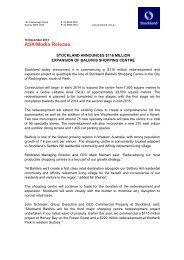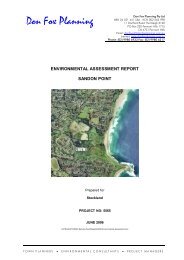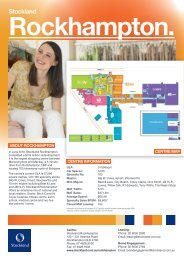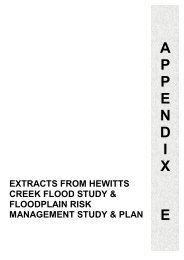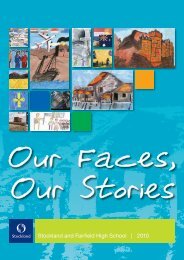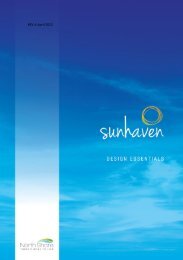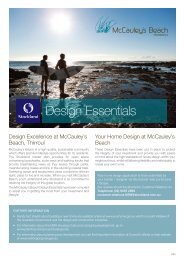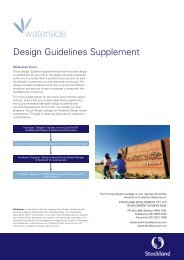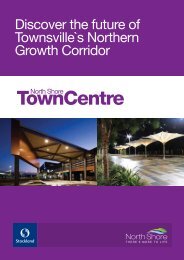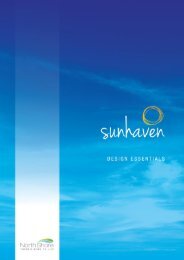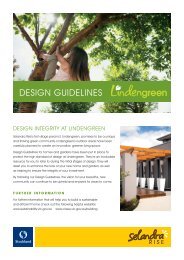Download PDF - Stockland
Download PDF - Stockland
Download PDF - Stockland
You also want an ePaper? Increase the reach of your titles
YUMPU automatically turns print PDFs into web optimized ePapers that Google loves.
Our natural environment<br />
Biodiversity<br />
In our endeavour to create sustainable<br />
developments we continue to examine<br />
how we impact the land we develop.<br />
Improving our knowledge of the plants,<br />
animals and ecosystems that are part<br />
of, or adjacent to, our sites enables us<br />
to retain and improve the biodiversity<br />
value of the land within our projects.<br />
Adequately assessing the biodiversity<br />
value of the sites we own and acquire also<br />
reduces the risk of planning delays. These<br />
delays may arise from environmental<br />
conservation legislation at state and<br />
federal levels of government, or from<br />
community concerns. In cases where we<br />
are developing a greenfield site, or the site<br />
has ecological or conservation value, we<br />
are required to produce an Environmental<br />
Impact Assessment.<br />
Development typically impacts<br />
biodiversity through the removal of<br />
native vegetation. As a result threatened<br />
species and their habitats, or corridors<br />
through which species migrate and<br />
forage, may be impacted.<br />
Examples of our approach to preserving<br />
and remediating environmentally significant<br />
landholdings include the Carnaby’s Black<br />
Cockatoo case study, relocating heathland<br />
at our Brightwater project in Queensland<br />
and remediating ground contamination<br />
at our Glenrose shopping centre.<br />
Our Residential sustainability policy<br />
includes a requirement for each project to<br />
conduct an ecological and/or biodiversity<br />
assessment to identify and preserve<br />
areas of prime significance. These<br />
assessments will contribute to building<br />
an understanding of our net biodiversity<br />
impacts and opportunities.<br />
Biodiversity management plans<br />
Biodiversity assessments have shown<br />
that several of our landholdings serve as<br />
habitat for threatened species. In FY10<br />
we reviewed our Residential Communities<br />
and Apartment projects – 33 per cent<br />
of these have threatened species<br />
or communities located on, or near,<br />
the projects.<br />
A quarter of the projects reviewed have<br />
biodiversity plans in place. Some approval<br />
authorities have required biodiversity<br />
management plans regardless of whether<br />
there are threatened species or impacted<br />
flora and fauna communities.<br />
Register of threatened species<br />
In the past year we have refined our<br />
register of threatened species and<br />
communities so that we can better<br />
understand our biodiversity holdings.<br />
Our register includes:<br />
• The area of our land that provides<br />
habitat for threatened species, and<br />
the entire area of local land that forms<br />
the habitat of threatened species.<br />
In each case, the relevant regulatory<br />
authority reviews our proposal. The<br />
outcome of this review process is that<br />
the habitat will usually be conserved<br />
on site or offset.<br />
• The area of land that provides habitat<br />
for threatened species that has<br />
been or is to be cleared. Species<br />
habitat may either be maintained<br />
within the development or cleared<br />
to accommodate development<br />
construction. We expect up to about<br />
170 hectares may be cleared in the<br />
projects reported this year, out of<br />
a total of 850 hectares serving as<br />
habitat to threatened species. Some<br />
of these projects remain in planning<br />
stages. This number may change<br />
as a result of further planning and<br />
approval processes. The remaining<br />
680 hectares of habitat to threatened<br />
species on our sites will likely be<br />
secured for ongoing conservation.<br />
• The area of land that has been<br />
regenerated or improved to provide<br />
habitat for threatened species. At this<br />
stage, about 55 hectares of land is<br />
under restoration nationally, including<br />
revegetation and weed removal.<br />
In FY11 we will use the knowledge gained<br />
through the use of our species register<br />
and management plans to review our<br />
biodiversity approach. We will develop<br />
best practice case studies of biodiversity<br />
management which will enable us to<br />
improve the capability of our development<br />
managers and their project teams.<br />
Biodiversity project updates<br />
Brightwater heath translocation<br />
process<br />
In 2008 we reported on our $5 million<br />
heath translocation project at<br />
Brightwater on Queensland’s Sunshine<br />
Coast. The project was a success, with<br />
the relocated heath taking well. Ongoing<br />
monitoring of the translocation is being<br />
undertaken by an approved independent<br />
arborist. The monitoring has confirmed<br />
that the performance requirements<br />
for the health of the heath-land,<br />
post-translocation, are being met or<br />
are progressing as expected. A further<br />
18 months of monitoring is required<br />
in accordance with the approvals, but<br />
we are confident that the translocation<br />
will remain a success throughout and<br />
beyond this monitoring period.<br />
Glenrose contamination<br />
As part of our demolition, remediation<br />
and proposed redevelopment<br />
works, we continue to monitor and<br />
manage the ground contamination<br />
we inherited when we acquired the<br />
<strong>Stockland</strong> Glenrose shopping centre<br />
in Northern Sydney. Indoor air-quality<br />
testing began in February 2010 in<br />
the operating parts of the centre<br />
and centre management office. A<br />
specialist consultant conducted a risk<br />
assessment for retailers, management<br />
and visitors and indicated that there is<br />
no adverse impact on human health. In<br />
March 2010, a six-month groundwater<br />
remediation pilot trial commenced<br />
as part of a Remediation Action Plan<br />
using a ‘biostimulation’ strategy.<br />
Further testing will continue to mid-2010<br />
in order to make a definitive assessment<br />
of the trial.<br />
<strong>Stockland</strong> Corporate Responsibility & Sustainability Report June 2010<br />
83



